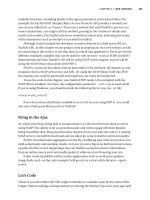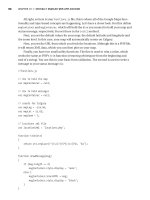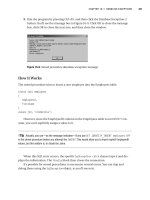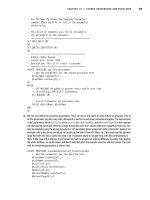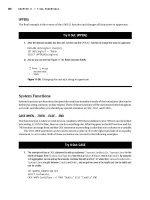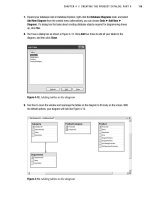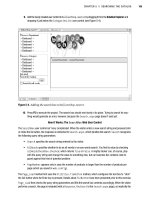Beginning ASP.NET 2.0 E-Commerce in C# 2005 From Novice to Professional PHẦN 9 pptx
Bạn đang xem bản rút gọn của tài liệu. Xem và tải ngay bản đầy đủ của tài liệu tại đây (2.21 MB, 70 trang )
CHAPTER 14 ■ ORDER PIPELINE
539
public void SetAuthCodeAndReference(string authCode,
string reference)
{
// call static method
CommerceLibAccess.SetOrderAuthCodeAndReference(OrderID,
authCode, reference);
// update fields
AuthCode = authCode;
Reference = reference;
}
public void SetDateShipped()
{
// call static method
CommerceLibAccess.SetOrderDateShipped(OrderID);
// update field
DateShipped = DateTime.Now.ToString();
}
Summary
You’ve started to build the backbone of the application and prepared it for the lion’s share of
the order pipeline processing functionality, which you’ll implement in Chapter 15.
Specifically, we’ve covered the following:
• The basic framework for your order pipeline
• The database additions for auditing data and storing additional required data in the
Orders table
• How to put orders into the pipeline when they are placed in BalloonShop
In the next chapter, you’ll go on to implement the order pipeline.
Darie-Watson_4681C14.fm Page 539 Friday, September 16, 2005 5:26 AM
Darie-Watson_4681C14.fm Page 540 Friday, September 16, 2005 5:26 AM
541
■ ■ ■
CHAPTER 15
Implementing the Pipeline
In the last chapter, you completed the basic functionality of the OrderProcessor component,
which is responsible for moving orders through pipeline stages. You’ve seen a quick demon-
stration of this using a dummy pipeline section, but you haven’t yet implemented the pipeline
discussed at the beginning of the last chapter.
In this chapter, you’ll add the required pipeline sections so that you can process orders
from start to finish, although you won’t be adding full credit card transaction functionality
until the next chapter.
We’ll also look at the web administration of orders by modifying the order admin pages
added earlier in the book to take into account the new order-processing system.
Considering the Code for the Pipeline Sections
The OrderProcessor code is complete, except for one important section—the pipeline stage
selection. Rather than forcing the processor to use PSDummy, you actually want to select one of
the pipeline stages outlined in Chapter 14, depending on the status of the order. Before you do
this, let’s run through the code for each of the pipeline sections in turn, and some new utility
code, which will take you to the point where the order pipeline is complete apart from actual
credit card authorization.
Business Tier Modifications
The first thing we’ll look at in this section is some modifications to the OrderProcessorMailer
class that are required for pipeline sections to send mail to customers and suppliers. After that,
we’ll move on to the pipeline sections; each section requires a new class in the App_Code/
CommerceLib folder. (Remember that this code is available in the Source Code area of the Apress
web site at ). By the time you get to the next “Exercise” section, you
should have eight new classes with the following names (they all start with PS, short for Pipe-
line Section):
• PSInitialNotification
• PSCheckFunds
• PSCheckStock
• PSStockOK
Darie-Watson_4681C15.fm Page 541 Friday, September 16, 2005 10:36 AM
542
CHAPTER 15
■ IMPLEMENTING THE PIPELINE
• PSTakePayment
• PSShipGoods
• PSShipOK
• PSFinalNotification
We’ll discuss the classes you are creating as you go.
OrderProcessorMailer Modifications
The OrderProcessorMailer class needs two new methods, MailCustomer and MailSupplier.
The new methods to add to OrderProcessorMailer are as follows:
public static void MailCustomer(MembershipUser customer,
string subject, string body)
{
// Send mail to customer
string to = customer.Email;
string from = BalloonShopConfiguration.CustomerServiceEmail;
Utilities.SendMail(from, to, subject, body);
}
public static void MailSupplier(string subject, string body)
{
// Send mail to supplier
string to = BalloonShopConfiguration.SupplierEmail;
string from = BalloonShopConfiguration.OrderProcessorEmail;
Utilities.SendMail(from, to, subject, body);
}
These methods use properties from BalloonShopConfiguration and the Utilities.
SendMail method to send mail to customers and suppliers.
OrderProcessor Modifications
As with MailAdmin, we’ll provide some new methods in OrderProcessor for mailing so that pipe-
line sections don’t use OrderProcessorMailer directly. The code for this is simply two new
methods as follows:
public void MailCustomer(string subject, string message)
{
OrderProcessorMailer.MailCustomer(Order.Customer, subject,
message);
}
public void MailSupplier(string subject, string message)
{
OrderProcessorMailer.MailSupplier(subject, message);
}
Darie-Watson_4681C15.fm Page 542 Friday, September 16, 2005 10:36 AM
CHAPTER 15 ■ IMPLEMENTING THE PIPELINE
543
Doing this is really according to personal taste. It wouldn’t really matter if order pipeline
sections used OrderProcessorMailer methods, although in the case of MailCustomer it does
simplify the syntax slightly.
ThePSInitialNotification Class
PSInitialNotification is the first pipeline stage and is responsible for sending an email to the
customer confirming that the order has been placed. The code for this class starts off in what
will soon become a very familiar fashion (the autogenerated using statements aren’t shown
here for brevity):
using System.Text;
namespace CommerceLib
{
/// <summary>
/// 1st pipeline stage - used to send a notification email to
/// the customer, confirming that the order has been received
/// </summary>
public class PSInitialNotification : IPipelineSection
{
private OrderProcessor orderProcessor;
public void Process(OrderProcessor processor)
{
// set processor reference
orderProcessor = processor;
// audit
orderProcessor.CreateAudit("PSInitialNotification started.",
20000);
The code contains one additional using statement; the class itself, which implements the
IPipelineSection interface; a private field for storing a reference to the order processor; and
then the IPipelineSection.Process method implementation. This method starts by storing
the reference to OrderProcessor, which all the pipeline sections will do because using the
members it exposes (either in the Process method or in other methods) is essential. An audit
entry is also added using the numbering scheme introduced earlier (the initial 2 signifies that
it’s coming from a pipeline section, the next 00 means that it’s the first pipeline section, and the
final 00 shows that it’s the start message for the pipeline section).
The remainder of the Process method sends the email, using the MailCustomer method of
OrderProcessor. A private method, GetMailBody(), is used to build a message body, which we’ll
look at shortly:
try
{
// send mail to customer
orderProcessor.MailCustomer("BalloonShop order received.",
GetMailBody());
Darie-Watson_4681C15.fm Page 543 Friday, September 16, 2005 10:36 AM
544
CHAPTER 15
■ IMPLEMENTING THE PIPELINE
After the mail is sent, you add an audit message to change the status of the order and tell
the order processor that it’s okay to move straight on to the next pipeline section:
// audit
orderProcessor.CreateAudit(
"Notification e-mail sent to customer.", 20002);
// update order status
orderProcessor.Order.UpdateStatus(1);
// continue processing
orderProcessor.ContinueNow = true;
}
If an error occurs, an OrderProcessor exception is thrown:
catch
{
// mail sending failure
throw new OrderProcessorException(
"Unable to send e-mail to customer.", 0);
}
If all goes according to plan, the Process method finishes by adding a final audit entry:
// audit
processor.CreateAudit("PSInitialNotification finished.", 20001);
}
The GetMailBody method is used to build up an email body to send to the customer using
a StringBuilder object for efficiency. The text uses customer and order data, but follows a
generally accepted e-commerce email format:
private string GetMailBody()
{
// construct message body
StringBuilder sb = new StringBuilder();
sb.Append("Thank you for your order! The products you have "
+ "ordered are as follows:\n\n");
sb.Append(orderProcessor.Order.OrderAsString);
sb.Append("\n\nYour order will be shipped to:\n\n");
sb.Append(orderProcessor.Order.CustomerAddressAsString);
sb.Append("\n\nOrder reference number:\n\n");
sb.Append(orderProcessor.Order.OrderID.ToString());
sb.Append(
"\n\nYou will receive a confirmation e-mail when this "
+ "order has been dispatched. Thank you for shopping "
+ "at BalloonShop!");
return sb.ToString();
}
}
}
Darie-Watson_4681C15.fm Page 544 Friday, September 16, 2005 10:36 AM
CHAPTER 15 ■ IMPLEMENTING THE PIPELINE
545
When this pipeline stage finishes, processing moves straight on to PSCheckFunds.
The PSCheckFunds Class
The PSCheckFunds pipeline stage is responsible for making sure that the customer has the required
funds available on a credit card. For now, you’ll provide a dummy implementation of this, and
just assume that these funds are available.
The code starts in the same way as PSInitialNotification, although without the reference
to the System.Text namespace:
namespace CommerceLib
{
/// <summary>
/// 2nd pipeline stage - used to check that the customer
/// has the required funds available for purchase
/// </summary>
public class PSCheckFunds : IPipelineSection
{
private OrderProcessor orderProcessor;
public void Process(OrderProcessor processor)
{
// set processor reference
orderProcessor = processor;
// audit
orderProcessor.CreateAudit("PSCheckFunds started.", 20100);
Even though you aren’t actually performing a check, you set the authorization and reference
codes for the transaction to make sure that the code in OrderProcessor works properly:
try
{
// check customer funds
// assume they exist for now
// set order authorization code and reference
orderProcessor.Order.SetAuthCodeAndReference("AuthCode",
"Reference");
You finish up with some auditing, the code required for continuation, and error checking:
// audit
orderProcessor.CreateAudit("Funds available for purchase.",
20102);
// update order status
orderProcessor.Order.UpdateStatus(2);
// continue processing
orderProcessor.ContinueNow = true;
}
Darie-Watson_4681C15.fm Page 545 Friday, September 16, 2005 10:36 AM
8213592a117456a340854d18cee57603
546
CHAPTER 15
■ IMPLEMENTING THE PIPELINE
catch
{
// fund checking failure
throw new OrderProcessorException(
"Error occured while checking funds.", 1);
}
// audit
processor.CreateAudit("PSCheckFunds finished.", 20101);
}
}
}
When this pipeline stage finishes, processing moves straight on to PSCheckStock.
The PSCheckStock Class
The PSCheckStock pipeline stage sends an email instructing the supplier to check stock availability:
using System.Text;
namespace CommerceLib
{
/// <summary>
/// 3rd pipeline stage – used to send a notification email to
/// the supplier, asking whether goods are available
/// </summary>
public class PSCheckStock : IPipelineSection
{
private OrderProcessor orderProcessor;
public void Process(OrderProcessor processor)
{
// set processor reference
orderProcessor = processor;
// audit
orderProcessor.CreateAudit("PSCheckStock started.", 20200);
Mail is sent in a similar way to PSInitialNotification, using a private method to build up
the body. This time, however, we use MailSupplier:
try
{
// send mail to supplier
orderProcessor.MailSupplier("BalloonShop stock check.",
GetMailBody());
As before, you finish by auditing and updating the status, although this time you don’t tell
the order processor to continue straight away:
Darie-Watson_4681C15.fm Page 546 Friday, September 16, 2005 10:36 AM
CHAPTER 15 ■ IMPLEMENTING THE PIPELINE
547
// audit
orderProcessor.CreateAudit(
"Notification e-mail sent to supplier.", 20202);
// update order status
orderProcessor.Order.UpdateStatus(3);
}
catch
{
// mail sending failure
throw new OrderProcessorException(
"Unable to send e-mail to supplier.", 2);
}
// audit
processor.CreateAudit("PSCheckStock finished.", 20201);
}
The code for building the message body is simple; it just lists the items in the order and
tells the supplier to confirm via the BalloonShop web site (using the order administration page
OrdersAdmin.aspx, which you’ll modify later):
private string GetMailBody()
{
// construct message body
StringBuilder sb = new StringBuilder();
sb.Append("The following goods have been ordered:\n\n");
sb.Append(orderProcessor.Order.OrderAsString);
sb.Append("\n\nPlease check availability and confirm via ");
sb.Append(" /> sb.Append("\n\nOrder reference number:\n\n");
sb.Append(orderProcessor.Order.OrderID.ToString());
return sb.ToString();
}
}
}
Note that the URL used here isn’t a real one—you should replace it with a URL of your
own. When this pipeline stage finishes, processing pauses. Later, when the supplier confirms
that stock is available, processing moves on to PSStockOK.
The PSStockOK Class
The PSStockOK pipeline section doesn’t do much at all. It just confirms that the supplier has
the product in stock and moves on. Its real purpose is to look for orders that have a status corre-
sponding to this pipeline section and know that they are currently awaiting stock confirmation.
Darie-Watson_4681C15.fm Page 547 Friday, September 16, 2005 10:36 AM
548
CHAPTER 15
■ IMPLEMENTING THE PIPELINE
namespace CommerceLib
{
/// <summary>
/// Summary description for PSStockOK
/// </summary>
public class PSStockOK : IPipelineSection
{
private OrderProcessor orderProcessor;
public void Process(OrderProcessor processor)
{
// set processor reference
orderProcessor = processor;
// audit
orderProcessor.CreateAudit("PSStockOK started.", 20300);
// the method is called when the supplier confirms that stock is
// available, so we don't have to do anything here except audit
orderProcessor.CreateAudit("Stock confirmed by supplier.",
20302);
// update order status
orderProcessor.Order.UpdateStatus(4);
// continue processing
orderProcessor.ContinueNow = true;
// audit
processor.CreateAudit("PSStockOK finished.", 20301);
}
}
}
When this pipeline stage finishes, processing moves straight on to PSTakePayment.
The PSTakePayment Class
The PSTakePayment pipeline section completes the transaction started by PSCheckFunds. As with
that section, you only provide a dummy implementation here.
namespace CommerceLib
{
/// <summary>
/// 5th pipeline stage – takes funds from customer
/// </summary>
public class PSTakePayment : IPipelineSection
{
private OrderProcessor orderProcessor;
Darie-Watson_4681C15.fm Page 548 Friday, September 16, 2005 10:36 AM
CHAPTER 15 ■ IMPLEMENTING THE PIPELINE
549
public void Process(OrderProcessor processor)
{
// set processor reference
orderProcessor = processor;
// audit
orderProcessor.CreateAudit("PSTakePayment started.", 20400);
try
{
// take customer funds
// assume success for now
// audit
orderProcessor.CreateAudit(
"Funds deducted from customer credit card account.",
20402);
// update order status
orderProcessor.Order.UpdateStatus(5);
// continue processing
orderProcessor.ContinueNow = true;
}
catch
{
// fund checking failure
throw new OrderProcessorException(
"Error occured while taking payment.", 4);
}
// audit
processor.CreateAudit("PSTakePayment finished.", 20401);
}
}
}
When this pipeline stage finishes, processing moves straight on to PSShipGoods.
The PSShipGoods Class
The PSShipGoods pipeline section is remarkably similar to PSCheckStock, because it sends an
email to the supplier and stops the pipeline until the supplier has confirmed that stock has
shipped. This operation should not be combined with PSCheckStock because after you’ve
checked that the goods are in stock, you need to take payment before shipping the goods.
using System.Text;
namespace CommerceLib
{
/// <summary>
/// 6th pipeline stage – used to send a notification email to
/// the supplier, stating that goods can be shipped
/// </summary>
Darie-Watson_4681C15.fm Page 549 Friday, September 16, 2005 10:36 AM
550
CHAPTER 15
■ IMPLEMENTING THE PIPELINE
public class PSShipGoods : IPipelineSection
{
private OrderProcessor orderProcessor;
public void Process(OrderProcessor processor)
{
// set processor reference
orderProcessor = processor;
// audit
orderProcessor.CreateAudit("PSShipGoods started.", 20500);
try
{
// send mail to supplier
orderProcessor.MailSupplier("BalloonShop ship goods.",
GetMailBody());
// audit
orderProcessor.CreateAudit(
"Ship goods e-mail sent to supplier.", 20502);
// update order status
orderProcessor.Order.UpdateStatus(6);
}
catch
{
// mail sending failure
throw new OrderProcessorException(
"Unable to send e-mail to supplier.", 5);
}
// audit
processor.CreateAudit("PSShipGoods finished.", 20501);
}
As before, a private method called GetMailBody is used to build the message body for the
email sent to the supplier:
private string GetMailBody()
{
// construct message body
StringBuilder sb = new StringBuilder();
sb.Append(
"Payment has been received for the following goods:\n\n");
sb.Append(orderProcessor.Order.OrderAsString);
sb.Append("\n\nPlease ship to:\n\n");
sb.Append(orderProcessor.Order.CustomerAddressAsString);
sb.Append(
"\n\nWhen goods have been shipped, please confirm via ");
sb.Append(" /> sb.Append("\n\nOrder reference number:\n\n");
sb.Append(orderProcessor.Order.OrderID.ToString());
Darie-Watson_4681C15.fm Page 550 Friday, September 16, 2005 10:36 AM
CHAPTER 15 ■ IMPLEMENTING THE PIPELINE
551
return sb.ToString();
}
}
}
Again, the URL used here isn’t a real one. When this pipeline stage finishes, processing
pauses. Later, when the supplier confirms that the order has been shipped, processing moves
on to PSShipOK.
The PSShipOK Class
The PSShipOK pipeline section is very similar to PSStockOK, although it has slightly more to do.
Because you know that items have shipped, a shipment date value can be added to the Orders
table. Technically, this isn’t really necessary, because all audit entries are dated. However, this
method ensures that all the information is easily accessible in one database table.
namespace CommerceLib
{
/// <summary>
/// 7th pipeline stage - after confirmation that supplier has
/// shipped goods
/// </summary>
public class PSShipOK : IPipelineSection
{
private OrderProcessor orderProcessor;
public void Process(OrderProcessor processor)
{
// set processor reference
orderProcessor = processor;
// audit
orderProcessor.CreateAudit("PSShipOK started.", 20600);
// set order shipment date
orderProcessor.Order.SetDateShipped();
// audit
orderProcessor.CreateAudit("Order dispatched by supplier.",
20602);
// update order status
orderProcessor.Order.UpdateStatus(7);
// continue processing
orderProcessor.ContinueNow = true;
// audit
processor.CreateAudit("PSShipOK finished.", 20601);
}
}
}
When this pipeline stage finishes, processing moves straight on to PSFinalNotification.
Darie-Watson_4681C15.fm Page 551 Friday, September 16, 2005 10:36 AM
552
CHAPTER 15
■ IMPLEMENTING THE PIPELINE
The PSFinalNotification Class
The last pipeline section—PSFinalNotification—is very similar to the first, in that it sends
email to the customer. This section confirms that the order has shipped:
using System.Text;
namespace CommerceLib
{
/// <summary>
/// 8th pipeline stage - used to send a notification email to
/// the customer, confirming that the order has been shipped
/// </summary>
public class PSFinalNotification : IPipelineSection
{
private OrderProcessor orderProcessor;
public void Process(OrderProcessor processor)
{
// set processor reference
orderProcessor = processor;
// audit
orderProcessor.CreateAudit("PSFinalNotification started.",
20700);
try
{
// send mail to customer
orderProcessor.MailCustomer("BalloonShop order dispatched.",
GetMailBody());
// audit
orderProcessor.CreateAudit(
"Dispatch e-mail sent to customer.", 20702);
// update order status
orderProcessor.Order.UpdateStatus(8);
}
catch
{
// mail sending failure
throw new OrderProcessorException(
"Unable to send e-mail to customer.", 7);
}
// audit
processor.CreateAudit("PSFinalNotification finished.", 20701);
}
It uses a familiar-looking GetMailBody method to build the body of the email:
Darie-Watson_4681C15.fm Page 552 Friday, September 16, 2005 10:36 AM
8213592a117456a340854d18cee57603
CHAPTER 15 ■ IMPLEMENTING THE PIPELINE
553
private string GetMailBody()
{
// construct message body
StringBuilder sb = new StringBuilder();
sb.Append("Your order has now been dispatched! The following "
+ "products have been shipped:\n\n");
sb.Append(orderProcessor.Order.OrderAsString);
sb.Append("\n\nYour order has been shipped to:\n\n");
sb.Append(orderProcessor.Order.CustomerAddressAsString);
sb.Append("\n\nOrder reference number:\n\n");
sb.Append(orderProcessor.Order.OrderID.ToString());
sb.Append("\n\nThank you for shopping at BalloonShop!");
return sb.ToString();
}
}
}
When this pipeline section finishes, the order status is changed to 8, which represents a
completed order. Further attempts to process the order using OrderProcessor result in an
exception being thrown.
The GetCurrentPipelineSection Method
There’s one more thing to add to OrderProcessor now that you have the proper pipeline
section classes—a full implementation of GetCurrentPipelineSection.
private void GetCurrentPipelineSection()
{
// select pipeline section to execute based on order status
switch (Order.Status)
{
case 0:
CurrentPipelineSection = new PSInitialNotification();
break;
case 1:
CurrentPipelineSection = new PSCheckFunds();
break;
case 2:
CurrentPipelineSection = new PSCheckStock();
break;
case 3:
CurrentPipelineSection = new PSStockOK();
break;
case 4:
CurrentPipelineSection = new PSTakePayment();
break;
Darie-Watson_4681C15.fm Page 553 Friday, September 16, 2005 10:36 AM
554
CHAPTER 15
■ IMPLEMENTING THE PIPELINE
case 5:
CurrentPipelineSection = new PSShipGoods();
break;
case 6:
CurrentPipelineSection = new PSShipOK();
break;
case 7:
CurrentPipelineSection = new PSFinalNotification();
break;
case 8:
throw new OrderProcessorException(
"Order has already been completed.", 100);
default:
throw new OrderProcessorException(
"Unknown pipeline section requested.", 100);
}
}
This method simply consists of a large switch statement that selects a pipeline section to
execute based on the status of the order being processed.
Presentation Tier Modifications
In a little while, you’ll be implementing a new order admin system, allowing suppliers to mark
orders as “in stock” or “shipped.” Before that, however, you can check that things are working
okay by providing a new test page. In fact, you can simply modify the OrderTest.aspx page you
used earlier in the book. You’ll do this in the following exercise and then we’ll analyze the results.
Exercise: Testing the Order Pipeline
1. Modify the code in OrderTest.aspx to add new user interface items as follows:
<strong>Order details:</strong>
<br />
<asp:Label runat="server" ID="orderLabel" />
<br />
<br />
<strong>Process order:</strong>
<br />
<asp:Button ID="processButton" runat="server" Text="Go"
Enabled="False" OnClick="processButton_Click" />
<br />
<asp:Label ID="processResultLabel" runat="server" />
</asp:Content>
Darie-Watson_4681C15.fm Page 554 Friday, September 16, 2005 10:36 AM
CHAPTER 15 ■ IMPLEMENTING THE PIPELINE
555
2. Modify the code for goButton_Click in OrderTest.aspx.cs as follows:
using CommerceLib;
protected void goButton_Click(object sender, EventArgs e)
{
try
{
CommerceLibOrderInfo orderInfo =
CommerceLibAccess.GetOrder(orderIDBox.Text);
resultLabel.Text = "Order found.";
addressLabel.Text =
orderInfo.CustomerAddressAsString.Replace(
"\n", "<br />");
creditCardLabel.Text = orderInfo.CreditCard.CardNumberX;
orderLabel.Text = orderInfo.OrderAsString.Replace(
"\n", "<br />");
processButton.Enabled = true;
processResultLabel.Text = "";
}
catch
{
resultLabel.Text =
"No order found, or order is in old format.";
addressLabel.Text = "";
creditCardLabel.Text = "";
orderLabel.Text = "";
processButton.Enabled = false;
}
}
3. Add a new click handler for the processButton button in OrderTest.aspx.cs as follows:
protected void processButton_Click(object sender, EventArgs e)
{
try
{
OrderProcessor processor =
new OrderProcessor(orderIDBox.Text);
processor.Process();
CommerceLibOrderInfo orderInfo =
CommerceLibAccess.GetOrder(orderIDBox.Text);
processResultLabel.Text = "Order processed, status now: "
+ orderInfo.Status.ToString();
}
Darie-Watson_4681C15.fm Page 555 Friday, September 16, 2005 10:36 AM
556
CHAPTER 15
■ IMPLEMENTING THE PIPELINE
catch
{
CommerceLibOrderInfo orderInfo =
CommerceLibAccess.GetOrder(orderIDBox.Text);
processResultLabel.Text =
"Order processing error, status now: "
+ orderInfo.Status.ToString();
}
}
4. Save the new files, log in, browse to the OrderTest.aspx page, select an existing order by its ID, and
then click on the button to process the first phase of the order.
5. Check your (customer account) mail for the customer notification email. An example is shown here:
Thank you for your order! The products you have ordered are as
follows:
1 Love Rose, $12.99 each, total cost $12.99
1 Love Cascade Hearts, $12.99 each, total cost $12.99
Shipping: By air (10 days, $35)
Total order cost: $60.98
Your order will be shipped to:
Charles Darwin
2nd Hut On The Left
The Beach
The Island
Santa Cruz
The Galapagos Islands
Order reference number:
11
You will receive a confirmation e-mail when this order has been
dispatched. Thank you for shopping at BalloonShop!
Darie-Watson_4681C15.fm Page 556 Friday, September 16, 2005 10:36 AM
CHAPTER 15 ■ IMPLEMENTING THE PIPELINE
557
6. Check your (administrator) mail for the stock check email (as shown next).
The following goods have been ordered:
1 Love Rose, $12.99 each, total cost $12.99
1 Love Cascade Hearts, $12.99 each, total cost $12.99
Shipping: By air (10 days, $35)
Total order cost: $60.98
Please check availability and confirm via
/>Order reference number:
11
7. Continue processing on the OrderTest.aspx page by clicking the button again, calling
OrderProcessor.Process for the second time.
8. Check your mail for the ship goods email:
Payment has been received for the following goods:
1 Love Rose, $12.99 each, total cost $12.99
1 Love Cascade Hearts, $12.99 each, total cost $12.99
Shipping: By air (10 days, $35)
Total order cost: $60.98
Please ship to:
Charles Darwin
2nd Hut On The Left
The Beach
The Island
Santa Cruz
The Galapagos Islands
Darie-Watson_4681C15.fm Page 557 Friday, September 16, 2005 10:36 AM
558
CHAPTER 15
■ IMPLEMENTING THE PIPELINE
When goods have been shipped, please confirm via
/>Order reference number:
11
9. Continue processing on the OrderTest.aspx page by clicking the button again, calling
OrderProcessor.Process for the third time.
10. Check your mail for the shipping confirmation email:
Your order has now been dispatched! The following products have
been shipped:
1 Love Rose, $12.99 each, total cost $12.99
1 Love Cascade Hearts, $12.99 each, total cost $12.99
Shipping: By air (10 days, $35)
Total order cost: $60.98
Your order has been shipped to:
Charles Darwin
2nd Hut On The Left
The Beach
The Island
Santa Cruz
The Galapagos Islands
Order reference number:
11
Thank you for shopping at BalloonShop!
11. Examine the new audit entries for the order (see Figure 15-1).
Darie-Watson_4681C15.fm Page 558 Friday, September 16, 2005 10:36 AM
CHAPTER 15 ■ IMPLEMENTING THE PIPELINE
559
Figure 15-1. Audit entries for completed order
How It Works: Testing the Order Pipeline
The example code tested your order pipeline by causing a single order to be processed by each pipeline section in
turn, and providing the expected results. The modifications to the OrderTest.aspx page and code behind provided a
button that simply called the OrderProcessor.Process method on the order being viewed. The other modifica-
tions to the code were to enable or disable the processing button depending on whether an order is being viewed.
One interesting point to note is what happens if you continue to try to process an order after it has been completed.
The result of clicking the processing button again is shown in Figure 15-2.
Darie-Watson_4681C15.fm Page 559 Friday, September 16, 2005 10:36 AM
8213592a117456a340854d18cee57603
560
CHAPTER 15
■ IMPLEMENTING THE PIPELINE
Figure 15-2. Order completed error
If you check your mail, you’ll see the details:
Message: Order has already been completed.
Source: 100
Order ID: 11
The error message mailed to the administrator should be enough to get started in detective work, finding out what
has happened.
Darie-Watson_4681C15.fm Page 560 Friday, September 16, 2005 10:36 AM
CHAPTER 15 ■ IMPLEMENTING THE PIPELINE
561
Administering BalloonShop Orders
The current order administration page, implemented in OrdersAdmin.aspx and
AdminUserControls\OrderDetailsAdmin.aspx, is no longer applicable to your order system.
Now you have new data to handle, new functionality required for suppliers, and an audit trail
to display.
This means you need to make several modifications. You’ll start, as usual, with the data-
base modifications, which require several new stored procedures. Moving on to the business
tier, you’ll need to update several methods and add several more to give access to the new
stored procedures and allow the presentation tier to obtain and update data. Finally, in the
presentation tier, you’ll need to update the files responsible for order administration.
Note that your new data structures mean that customer-related information, including the
customer name, email address, and postal address, are no longer editable by administrators. It
would be possible to do this, but because customers can edit that information themselves, we
won’t implement it here. In fact, at some point, it might be nice to add a customer administra-
tion page, usable by administrators, to check on customer activity and edit customer accounts.
We’ll leave this task to you because by the end of this book, you’ll be familiar with all the necessary
techniques.
Database Modifications
As noted, the required additions here are all stored procedures. In addition, they all start with
the string CommerceLib to distinguish them from earlier additions. This is especially necessary
as many of these stored procedures (and the business tier methods that use them) will replace
or upgrade existing functionality.
The CommerceLibOrderGetAuditTrail Stored Procedure
This stored procedure gets the Audit table entries that are associated with a given order:
CREATE PROCEDURE CommerceLibOrderGetAuditTrail
(@OrderID int)
AS
SELECT OrderID,
AuditID,
DateStamp,
Message,
MessageNumber
FROM Audit
WHERE OrderID = @OrderID
The CommerceLibOrdersGetByCustomer Stored Procedure
This stored procedure gets the orders that have been made by a specific customer by using the
GUID that identifies a customer:
Darie-Watson_4681C15.fm Page 561 Friday, September 16, 2005 10:36 AM
562
CHAPTER 15
■ IMPLEMENTING THE PIPELINE
CREATE PROCEDURE CommerceLibOrdersGetByCustomer
(@CustomerID uniqueidentifier)
AS
SELECT OrderID,
DateCreated,
DateShipped,
Comments,
Status,
CustomerID,
AuthCode,
Reference,
Orders.ShippingID,
ShippingType,
ShippingCost,
Orders.TaxID,
TaxType,
TaxPercentage
FROM Orders
LEFT OUTER JOIN Tax ON Tax.TaxID = Orders.TaxID
LEFT OUTER JOIN Shipping ON Shipping.ShippingID = Orders.ShippingID
WHERE CustomerID = @CustomerID
The CommerceLibOrdersGetByDate Stored Procedure
This stored procedure mirrors the OrdersGetByDate stored procedure used earlier in the book.
As with that stored procedure, this one gets the orders that were placed between two dates. The
difference here is that different data is returned:
CREATE PROCEDURE CommerceLibOrdersGetByDate
(@StartDate smalldatetime,
@EndDate smalldatetime)
AS
SELECT OrderID,
DateCreated,
DateShipped,
Comments,
Status,
CustomerID,
AuthCode,
Reference,
Orders.ShippingID,
ShippingType,
ShippingCost,
Orders.TaxID,
TaxType,
TaxPercentage
Darie-Watson_4681C15.fm Page 562 Friday, September 16, 2005 10:36 AM
CHAPTER 15 ■ IMPLEMENTING THE PIPELINE
563
FROM Orders
LEFT OUTER JOIN Tax ON Tax.TaxID = Orders.TaxID
LEFT OUTER JOIN Shipping ON Shipping.ShippingID = Orders.ShippingID
WHERE DateCreated BETWEEN @StartDate AND @EndDate
ORDER BY DateCreated DESC
The CommerceLibOrdersGetByRecent Stored Procedure
This stored procedure replaces the OrdersGetByRecent stored procedure. It obtains the most
recent orders that have been placed, where the number of orders to return is selected by a
parameter:
CREATE PROCEDURE CommerceLibOrdersGetByRecent
(@Count smallint)
AS
SET ROWCOUNT @Count
SELECT OrderID,
DateCreated,
DateShipped,
Comments,
Status,
CustomerID,
AuthCode,
Reference,
Orders.ShippingID,
ShippingType,
ShippingCost,
Orders.TaxID,
TaxType,
TaxPercentage
FROM Orders
LEFT OUTER JOIN Tax ON Tax.TaxID = Orders.TaxID
LEFT OUTER JOIN Shipping ON Shipping.ShippingID = Orders.ShippingID
ORDER BY DateCreated DESC
SET ROWCOUNT 0
The CommerceLibOrdersGetByStatus Stored Procedure
Again, this stored procedure is a replacement. However, this time the new stored procedure
actually replaces two earlier ones: OrdersGetUnverifiedUncanceled and OrdersGetVerified➥
Uncompleted. Because this information is now represented by a single status field, you can
provide a single, more versatile stored procedure:
Darie-Watson_4681C15.fm Page 563 Friday, September 16, 2005 10:36 AM

